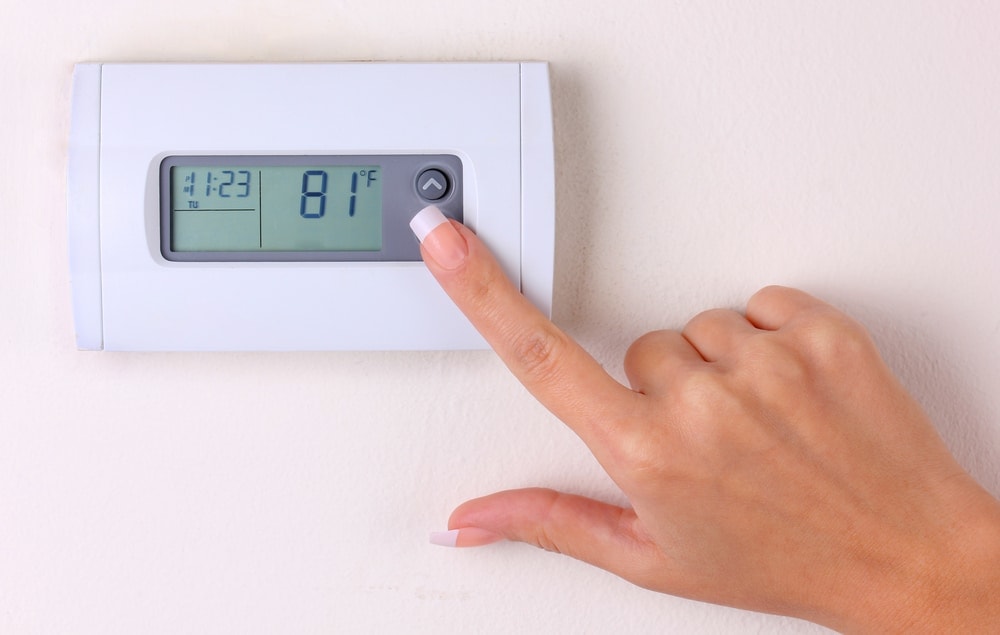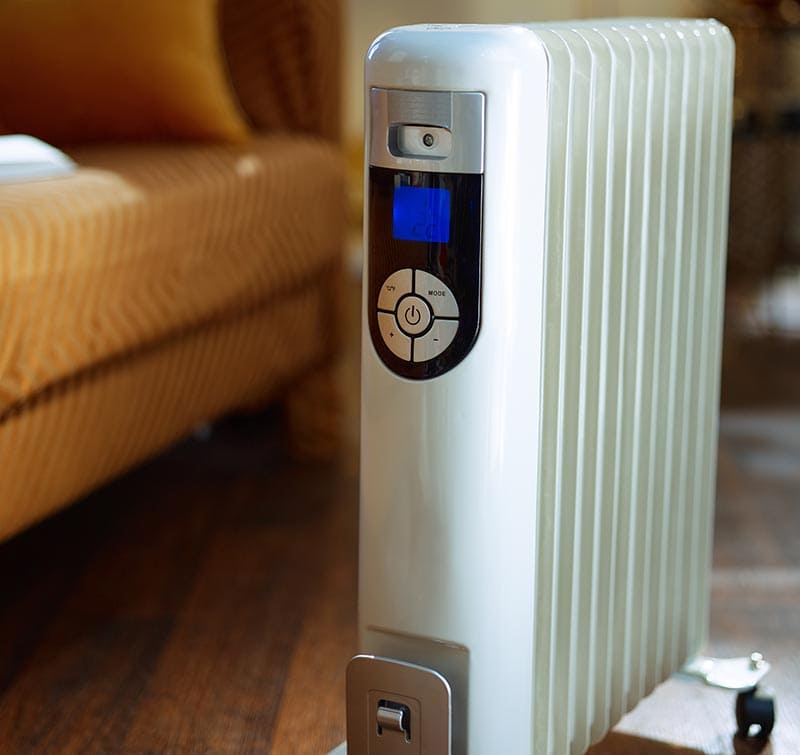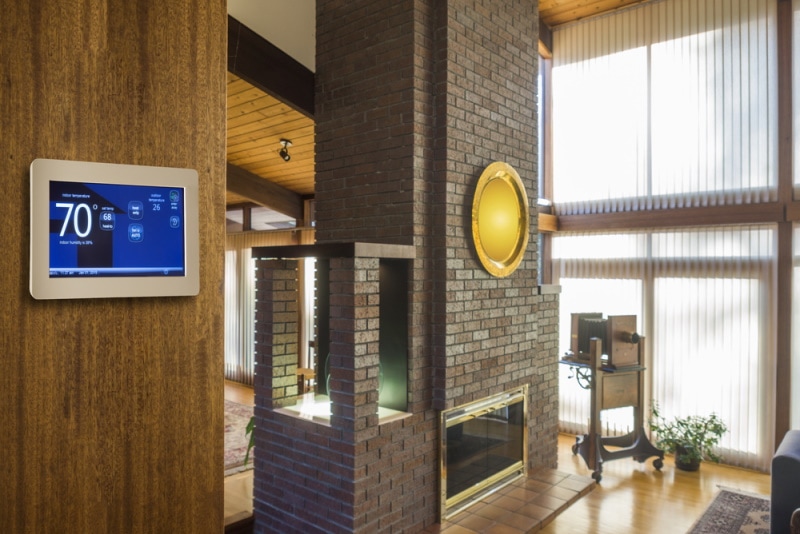How Does a Thermostat Work? What You Need To Know!
-
Pete Ortiz
- Last updated:

A thermostat is an essential part of our lives. We use them daily to regulate the temperature inside our homes, offices, and other spaces. But have you ever wondered just exactly how does a thermostat work? In this article, we’ll explain the basics of thermostats and how they work to keep us comfortable year-round.
How Does a Thermostat Work?
Thermostats are remarkable pieces of technology, as they measure and respond to the temperature around you. By utilizing this information, your thermostat can ensure that your air conditioning or heating system works to keep your home at a comfortable level according to what you desire.
The thermostat can fine-tune your room’s temperature by opening and closing furnace connections. This all works thanks to an electrical coil embedded inside that function as a temperature sensor, allowing it to identify any fluctuations in temperature.
As the temperature rises beyond your desired setting, the coil will extend and close off access to the furnace. Conversely, should it dip below your set degree, this same coil shrinks back into its normal size, opening the connection with the furnace once more, allowing heat to flow in and warm up any space accordingly.
As you can see, it’s a simple yet incredibly effective way of maintaining a comfortable environment all year round.
And if you invest in a smart thermostat, you’ll gain access to features that allow you to control your thermostat from your phone. This means you won’t have to worry about leaving the house and returning to find a super uncomfortable temperature. Instead, you’ll be able to adjust it as needed wherever you are easily. Smart thermostats are an excellent way to maximize your energy savings, as they can reduce your energy bills thanks to their precise temperature-controlling capabilities.
What Are the Different Types of Thermostats?

When considering what type of thermostat is best for your needs, you have several options to choose from. In this section, we will dive into the details of smart thermostats and other varieties available on the market.
Smart Thermostats
As previously discussed, smart thermostats are the ultimate convenience when it comes to controlling your home’s heating and cooling. By utilizing an app on either your smartphone or tablet, you can conveniently manage temperature settings while simultaneously optimizing energy-saving efforts.
These thermostats can be programmed to remember what temperatures you prefer and automatically switch to those settings at specific times of the day or week. It’s an energy-saving device with tons of additional features that makes your home more comfortable than ever.
Programmable Thermostats
Programmable thermostats are an ideal solution for anyone seeking both convenience and comfort. You can maintain precise temperature settings throughout the day, tailored to your individual preferences each day of the week! All it takes is one press of a button—no more fiddling around with knobs or switches. Just effortless control over your home’s climate at any given time.

Non-Programmable Thermostats
Despite the rise of modern technology, you can still acquire non-programmable thermostats. Whether digital or mechanical versions, these fundamental models offer just one setting with direct control over temperature—but only through manual alteration each time it needs to be adjusted. In other words, you must set the desired temperature yourself every single time.
This carries some obvious risks. Namely, there’s never even energy regulation. That means you’ll use more energy than necessary, which can quickly cause your energy bills to skyrocket.
Wi-Fi Thermostats
Wi-Fi thermostats are like smart thermostats in that they can be adjusted remotely via an app on your phone or tablet. Although similar, these devices do not offer as many features as their “smart” counterparts. While you will still be able to save energy and adjust your home’s temperature from anywhere, the lack of additional features makes them a less attractive option than smart thermostats.
Whichever type of thermostat you choose, make sure it suits your needs and budget. Given that there are so many different types to choose from, you shouldn’t have any trouble finding the perfect fit for your space.
Where Is It Used?

Just about everywhere, really. Thermostats can be used in homes, apartment complexes, public buildings, and commercial properties alike. They can be situated in any room or area to regulate the temperature of that specific space—regardless of size or capability.
Overall, thermostats make life easier for building operators and occupants alike, proving their worth time and time again. With clearly set comfort levels and precision temperature control, everyone involved stands to benefit.
Whether you’re looking for a new thermostat or simply want to upgrade the old one in your home, there is no shortage of options available—each with its own unique features and advantages.
From smart thermostats to programmable ones, considering what type of thermostat is right for you is the first step toward enjoying a comfortable, energy-efficient home. Making such an investment now can save you money in the long run, so it’s worth taking the time to explore your options.
Advantages of Thermostats
Thermostats offer great benefits for both your comfort and pocketbook. As we’ve already pointed out, automatically adjusting the temperature of your home or office according to the time of day or desired settings can save you a lot of money on energy bills.
Plus, you don’t have to worry about manually changing the temperature—you can just set it and forget it! You can also program your thermostat for different settings during the week, such as setting a lower temperature when you’re away from home or the office. This prevents energy from being wasted unnecessarily.
Lastly, many smart thermostats today offer additional features such as remote access, indoor air quality monitoring, and more, allowing you to monitor and adjust your thermostat from anywhere you have an internet connection. Now that’s convenient!
By properly using a thermostat, you can take control of your energy consumption and stay comfortable while helping the environment at the same time. So go ahead, install your thermostat today, and start saving the planet—and your money!
Disadvantages of Thermostats
As wonderful as they are, thermostats aren’t perfect. They can be difficult to program, and depending on the model you have, they may not offer a wide range of temperature control options.
This means you can have a hard time getting your home just the right temperature during different seasons, especially for those who are sensitive to temperatures. Additionally, thermostats tend to lose their accuracy over time, which means you may find yourself in the uncomfortable situation of your home is too cold or too hot when you need it to be just right.
Another downside to having a thermostat is that they require regular maintenance and calibration for it to work properly. This can mean additional costs for materials and labor if done by a professional. If you don’t maintain your thermostat, it can lead to energy inefficiency and higher electric bills—so it’s important to be sure that you’re taking good care of yours!
Finally, installing a thermostat in an older home may require more work than simply affixing the unit to the wall. You may need to run new wiring or replace components for the thermostat to work. It’s important to consult a professional if you plan on upgrading your home’s heating and cooling system, as it can be dangerous—and expensive—to do this kind of work yourself.
Overall, thermostats are great tools for keeping your home comfortable and energy-efficient. However, it’s important to keep in mind the potential drawbacks that may come with using one, so you can be sure you’re getting the most out of your thermostat!
 Frequently Asked Questions (FAQs)
Frequently Asked Questions (FAQs)

How can I tell if my thermostat is working correctly?
To test your thermostat, simply adjust the temperature and observe how quickly the air coming out of your vents reacts. If it takes too long for you to notice any changes in your home’s climate, then there may be a problem with your thermostat that needs addressing.
What are some alternatives to using a thermostat?
If you’re seeking an alternative way to control the temperature of your home without dealing with some of the restrictions that accompany a thermostat, consider investing in a smart device or Wi-Fi-enabled model. Manual controls also exist and can be adjusted through turn dials and switches if desired.
What are some of the benefits of using a thermostat?
Utilizing a thermostat is the key to optimally controlling your energy costs. With it, you can precisely monitor and adjust the temperature of your home with ease – from winter chill to summer heat. It allows for comfortable temperatures throughout all seasons while also minimizing expenses associated with wasted energy.
Conclusion
Before purchasing a thermostat, consider the potential drawbacks and do your research. Get to know how thermostats work, factor in any possible installation or maintenance costs that may arise, and explore the features available on different models.
Nevertheless, once you have all the right information at hand, along with proper care for it, you will find that investing in a thermostat can be great both for your home’s comfort level as well as its energy efficiency!
Featured Image Credit: ri, Pixabay
Contents



 Frequently Asked Questions (FAQs)
Frequently Asked Questions (FAQs)